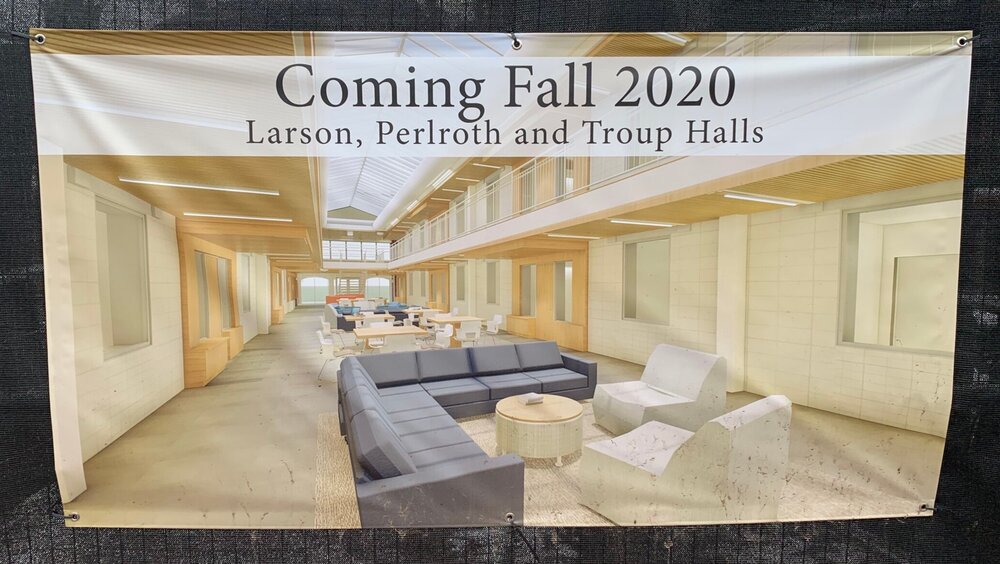By Kim Kerremans
Vice President and Dean of Students Monique Drucker stated that residence halls Larson, Troup and Perlroth will be ready for the 2020-2021 academic year with air conditioning and will be asbestos-free.
Quinnipiac University had to shut down three residence halls over the summer after finding materials containing asbestos during renovations.
Students living in these three residence halls, Larson, Perlroth and Troup, had to deal with rearrangements of housing.
The sophomores who selected to live in Larson and Perlroth were moved to Mountainview, Founders and Crescent on York Hill.

Construction vehicle in front of Perlroth residence hall.
The students affected received a $1,000 housing credit, $400 for the Fall 2019 semester and $600 for the Spring 2020 semester. Students that were assigned Crescent on York Hill will receive an upgraded parking permit which allows Hilltop parking on Mount Carmel campus daily from 6 a.m. until midnight.
Drucker sent out an email notifying students on the issue.
“I write to advise you that the Larson, Perlroth and Troup Residence Halls will not be available for occupancy during the 2019-2020 academic year, as previously planned,” wrote Drucker. “Students who were scheduled to reside in the suites will now be assigned to alternative on-campus residence hall.”
Students were given new housing assignments through MyHousing. Many suites were divided up without being told or provided other options prior to this.
“I was supposed to live in Perlroth with seven of my friends, but I was moved up to York and two of my friends were put in a different room,” said sophomore Elizabeth McGrann.
Asbestos is a common term used to describe “groups of naturally occurring fibrous material known to cause cancer,” according to the Connecticut Department of Health.

Up until 1989 asbestos was used globally, however in the United States it is banned. You cannot build and use asbestos, but if it is in buildings predated 1989 they do not need to be taken down.
Jose C. Alvarez, assistant teaching professor of civil engineering at Quinnipiac, explained some of the challenges associated with asbestos removal.
“The removal of asbestos is costly and it does take some time since you need to seal the spaces and you need to go little by little,” he said. “It’s not like you can do the building all in one go.”
According to the United States Environmental Protection Agency, they issued a final rule banning most asbestos-containing products. “Which went into effect in 1991 after the regulation was overturned by the Fifth Circuit Court of Appeals in New Orleans. This regulation banned new uses of asbestos products that would be initiated for the first time after 1989.”

Aerial picture from April 1991 of Quinnipiac University, circled are the residence halls where asbestos was found.
Larson, one of the very first residential halls at Quinnipiac, was built in 1965, a time when asbestos was widely used. Then in 1966, Neil Salon became the third president of Quinnipiac and he sought to expand the institution. Under his leadership, two new residence halls were built: Irma Tator and Dana.
These three halls were built when the health risks of asbestos were not widely known.

Aerial picture from November 2019 of Quinnipiac University, circled are the residence halls where asbestos was found.
“Asbestos is really dangerous for you to inhale, being in contact with it, so as soon as you find it and it has been impacted in some way, meaning it went out into the air, you need to remove it,” Alvarez said. “The removal process is usually to clean it and remove it, it requires you to seal EPA, Haz Mat suits and seal the area and then wet clean/vaccum the whole thing as you are removing it.”

The “Coming Soon” banner on the construction barriers.
Different residential halls hold different amount of students per suite, many groups had to be split up. Quinnipiac Residential Life divided these rooms without asking the students what they wanted. They were just reassigned.
“It felt surreal, the housing selection process is so tough and I had dealt with it, but then finding out a couple months later that I was assigned a different room with different people, it was hard,” said sophomore Evie Casey.
Hamden’s Building Official, Robert Labulis, applied for air conditioning permits, which initiated the renovation. According to Labulis the University’s Connecticut-licensed asbestos consultant inspected the buildings and determined that certain material in the buildings contained asbestos.
Regarding students’ health concerns Labulis said, “unless students were chewing on the walls then their health in the buildings were not at risk.”

Gates set up in front or Troup and Larson residence halls to keep students out of the construction site.
“Students were not at risk because it wasn’t in the air. It needs to have been broken down and have been in the air,” Alvarez said. “Asbestos works that as long as you are not impacting it, like if you are not making holes to put a TV on the wall, you should be fine with asbestos inside your walls.”
According to Sal Filardi, vice president for facilities and capital planning, you are not required to remove asbestos if it was put there before 1989. However the University decided to remove all of the asbestos.
“We could have painted over the walls and carpet the floor and we wouldn’t have to worry about the asbestos,” Filardi said.
Almost five months after the news broke of asbestos being found in residence halls, the buildings are still closed and are currently being renovated.
“Even though those buildings are going to be asbestos free, it will take them a year to finish,” Casey said. “The school isn’t going to do any renovations on other buildings because they know they will find asbestos and with the mess from this past summer they probably aren’t going to risk it again.”